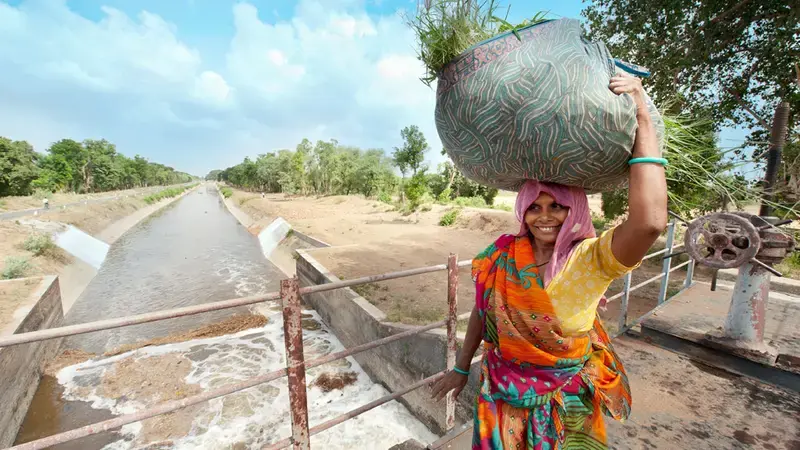Why water management in drylands matters more than you think?

On the occasion of World Water Day 2016, the CGIAR Research Program on Dryland Systems calls on all partners and stakeholders to rise to the collective challenge of managing water resources in a sustainable way in order to improve livelihoods and job opportunities, particularly in rural dryland communities of the developing world.
The theme of 2016 World Water Day – Better Water, Better Jobs – recognizes that the availability and sustainable management of water resources can create quality jobs, while contributing to green and sustainable development.
Water is life, and in the drylands, life and livelihoods truly depend on it. By definition, drylands are regions of water scarcity. Though they occupy 41 percent of the earth's surface and are home to one third of the world’s population, drylands possess only an estimated 8 percent of the global renewable water supply. At just 1300 cubic meters per year, per capita availability of water in drylands is substantially below the global average and lower than the minimum amount (2000 cubic meters) required to meeting human needs.
The implications of effective management of water are obvious for drylands agriculture and rural livelihoods, as well as critical to achieving of the Sustainable Development Goals by 2030. With food demand predicted to increase 50% by 2030 demand for water will certainly increase. With increased demand, water use in arid regions must become more efficient and even attempt to create a climate with more moisture through processes such as re-forestation and water harvesting.
That is why identifying solutions to water-related issues in drylands is a significant aspect of the research work carried out by the CGIAR Research Program on Dryland Systems. A clear contribution to such efforts in this regard is a recent publication on the Multifaceted Impacts of Sustainable Land Management in Drylands: A Review, which examines – among other issues - water management and the rehabilitation of ecosystem services from a wide systems perspective, taking into account both biophysical and socio-economic factors.
To boost agricultural productivity and reduce risk through the efficient and sustainable use of limited water resources in drylands, research scientists, development professionals and policy makers must work together with rural people to examine options that are suited to various contexts and at different scales - from farm to landscape level - to develop and apply improved management practices and technologies. Our research underscores the importance of socio-economic factors affecting the successful adoption and long-term maintenance of sustainable water and land management practices.
Water scarcity is a constant problem for dryland countries and a growing one globally in the face of increasing population and food demand, climate change, rising temperatures and frequent droughts, land degradation and desertification. The Middle East and North Africa is the most water scarce region in the world, and the problem is set to deteriorate. Increasing water shortages, poor water quality, droughts, or floods accentuated by climate change and demographic changes can significantly threaten peace and stability. Famines and other disasters are affecting drylands with increasing intensity, and with climate change, such events may become even more frequent.
Our body of research indicates that there is scope to use scarce water resources more efficiently through better crop and soil management, such as conservation agriculture, integrated crop production practices, the revival of traditional knowledge on water harvesting, building dams to harvest floodwaters, creating reservoirs for rainwater and treated wastewater, rehabilitating rivers and streams, developing advanced water technology, and more.
These are not only essential to improving agricultural productivity and ecosystem health in drylands, but also to changing farmer’s lives and livelihoods, and transform entire societies and economies. We must also not forget the link between water, population health, and economic growth. The basic provision of adequate water, sanitation and hygiene (WASH) services at home and in the workplace enables a robust economy by contributing to a healthy and productive population and workforce, with benefit-to-cost ratios as high as 7 to 1 for basic water and sanitation services in developing countries.
In 1992, the United Nations Conference of Environment and Development recommended that the UN General Assembly designate March 22 as annual World Water Day, when countries and people worldwide focus on water-related issues and how to positively affect the world’s water economy.
Today, the CGIAR Research Program on Dryland Systems marks this occasion by strongly encouraging sustainable and collaborative approaches to research on water management across disciplines and the globe in order to provide tried and tested water management solutions that lead to better jobs, prosperity and good health, sustainable and equitable development, political stability, and peace and security in both the developing drylands and the world.
If we are to achieve the Sustainable Development Goals, we must all do our part to support improvements in water productivity and conservation by adopting wiser practices and policies that incentivize efficient and sustainable water use, while meeting the needs of the world’s poorest and hungriest.
About the author
Dr. Richard Thomas is the Director of the CGIAR Research Program on Dryland Systems
Note
This statement first appeared on the CGIAR Research Program on Drylands Systems website.
